In the dynamic world of visual communication, finding the right graphic designer for your team is crucial. The interview process is your opportunity to assess a candidate's skills, creativity, and fit for your organization.
This blog post provides a comprehensive list of interview questions tailored for graphic designers at various experience levels. From basic queries to advanced design principles, we cover a wide range of topics to help you evaluate candidates effectively.
By using these questions, you can gain valuable insights into a designer's expertise and problem-solving abilities. Consider pairing these interview questions with a graphic design skills assessment for a more thorough evaluation of potential hires.
Table of contents
15 basic Graphic Designer interview questions and answers to assess applicants

To effectively evaluate if a candidate possesses the essential skills for a graphic designer job, consider utilizing these carefully curated interview questions. They are designed to provide insights into the applicant's fundamental abilities and creative approach.
- Can you describe your design process from concept to completion?
- How do you handle criticism of your design work?
- What software tools do you commonly use and why?
- Can you provide an example of a design project you are particularly proud of and explain why?
- How do you prioritize tasks when juggling multiple design projects?
- Describe your experience with collaborating in a team setting.
- How do you stay updated with the latest design trends and tools?
- What steps do you take to ensure your designs are aligned with the client’s brand?
- How do you handle tight deadlines and pressure in a design project?
- Can you explain how you incorporate feedback into your designs?
- What are your sources of inspiration when working on a new project?
- Describe a challenging design project and how you overcame the obstacles.
- How do you ensure accessibility in your designs?
- Do you have experience working with cross-functional teams, and how do you manage it?
- What do you think is the most important quality a graphic designer should have?
8 Graphic Designer interview questions and answers to evaluate junior designers
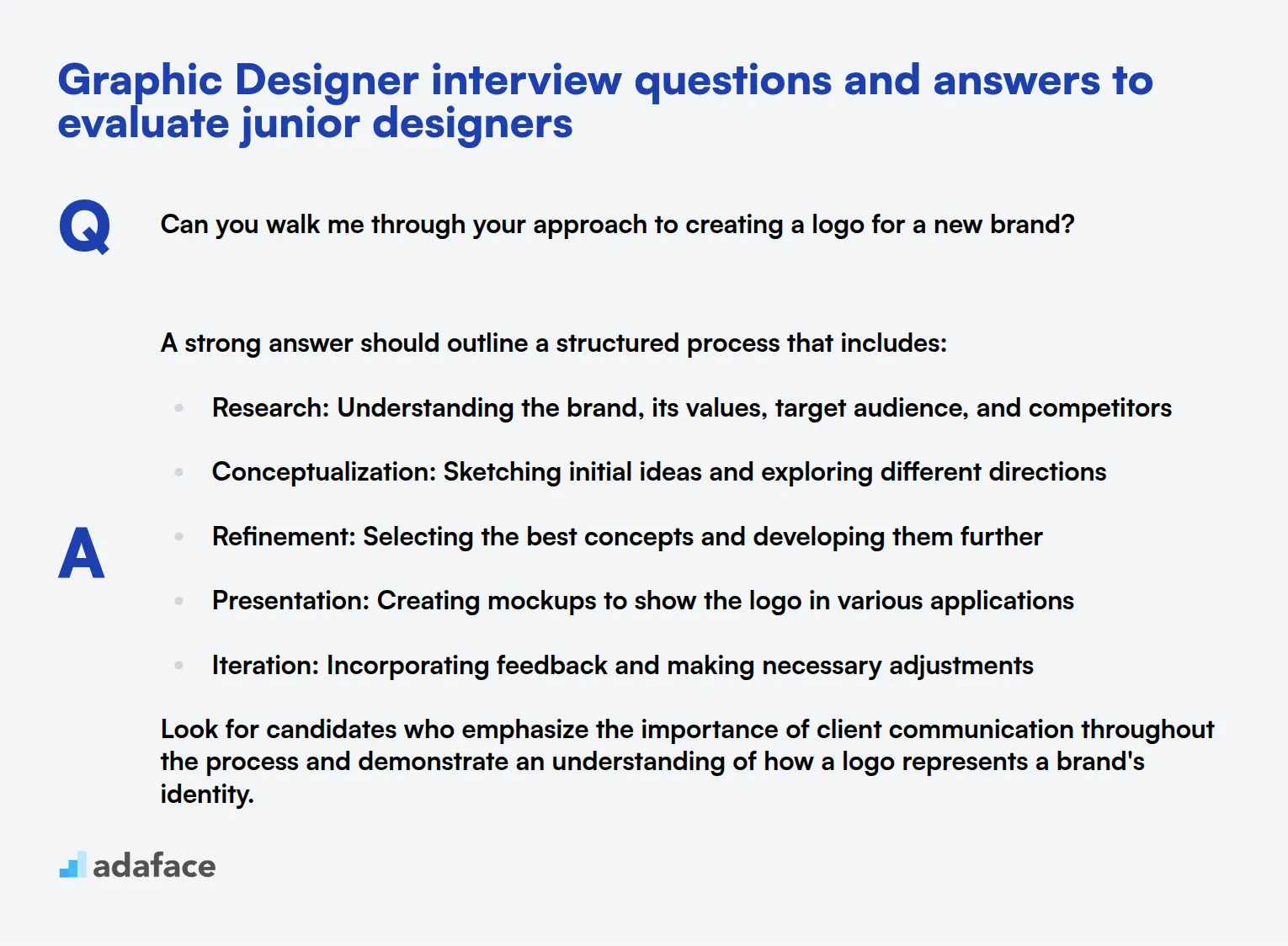
When interviewing junior graphic designers, it's crucial to assess their foundational skills and creative potential. These eight questions will help you evaluate their design process, problem-solving abilities, and adaptability. Use this list to uncover the talents that will make a junior designer shine in your team.
1. Can you walk me through your approach to creating a logo for a new brand?
A strong answer should outline a structured process that includes:
- Research: Understanding the brand, its values, target audience, and competitors
- Conceptualization: Sketching initial ideas and exploring different directions
- Refinement: Selecting the best concepts and developing them further
- Presentation: Creating mockups to show the logo in various applications
- Iteration: Incorporating feedback and making necessary adjustments
Look for candidates who emphasize the importance of client communication throughout the process and demonstrate an understanding of how a logo represents a brand's identity.
2. How do you approach designing for different mediums (print vs. digital)?
A good candidate should recognize the key differences between print and digital design:
- Color systems: CMYK for print, RGB for digital
- Resolution: Higher DPI for print, lower resolution for web
- Interactivity: Static for print, potential for animation and interaction in digital
- File formats: Print-ready formats (PDF, TIFF) vs. web-optimized formats (JPG, PNG, SVG)
Look for designers who understand the importance of adapting designs for different mediums and can explain how they would adjust their approach accordingly. They should also mention the importance of creating flexible designs that work across multiple platforms.
3. How do you ensure your designs are accessible to users with disabilities?
A thoughtful answer should cover several aspects of accessibility in design:
- Color contrast: Using tools to check contrast ratios for readability
- Typography: Choosing legible fonts and appropriate sizes
- Alternative text: Providing descriptive text for images
- Keyboard navigation: Ensuring designs can be navigated without a mouse
- Screen reader compatibility: Structuring content logically
Look for candidates who demonstrate awareness of WCAG guidelines and show empathy towards users with different abilities. They should understand that accessibility is not an afterthought but an integral part of the design process.
4. How do you handle a situation where a client doesn't like your initial design concepts?
A mature response should include the following steps:
- Listen carefully to the client's feedback without becoming defensive
- Ask specific questions to understand their concerns and preferences
- Review the initial brief to ensure all requirements were met
- Propose alternative solutions based on the new information
- Collaborate with the client to find a direction that satisfies their needs
Look for candidates who demonstrate professionalism, flexibility, and strong communication skills. They should view feedback as an opportunity for improvement rather than criticism.
5. Can you describe a time when you had to work within strict brand guidelines? How did you maintain creativity?
A good answer should demonstrate the candidate's ability to balance creativity with consistency:
- Understanding the purpose of brand guidelines and their importance
- Finding creative solutions within the established framework
- Using the guidelines as a springboard for ideas rather than a limitation
- Proposing thoughtful deviations when appropriate, with clear rationales
Look for designers who can articulate how they've successfully worked within constraints while still producing innovative designs. They should show respect for established brand identities while demonstrating their ability to bring fresh perspectives.
6. How do you stay organized when working on multiple projects simultaneously?
An effective answer might include:
- Using project management tools (e.g., Trello, Asana) to track tasks and deadlines
- Creating a structured file naming and organization system
- Prioritizing tasks based on urgency and importance
- Setting realistic timelines and communicating them clearly to stakeholders
- Taking regular breaks to maintain focus and prevent burnout
Look for candidates who demonstrate strong time management skills and the ability to juggle multiple responsibilities. They should also mention the importance of communication with team members and clients to manage expectations.
7. How do you approach designing for a target audience that's very different from yourself?
A comprehensive answer should include:
- Conducting thorough research on the target demographic
- Creating user personas to better understand the audience's needs and preferences
- Seeking input from individuals who represent the target audience
- Testing designs with focus groups or through user testing sessions
- Being open to feedback and willing to iterate based on user insights
Look for candidates who show empathy and a genuine interest in understanding diverse perspectives. They should recognize the importance of user-centered design and be able to set aside personal preferences in favor of what works best for the target audience.
8. Can you explain your process for choosing typography in a design project?
A well-thought-out answer should cover:
- Considering the brand personality and the message to be conveyed
- Evaluating readability and legibility for different contexts (print, web, mobile)
- Selecting font pairings that complement each other
- Testing different options to find the best hierarchy and visual balance
- Ensuring the chosen fonts are licensed for the intended use
Look for candidates who understand the impact of typography on design and can articulate how they make informed decisions. They should also demonstrate knowledge of typographic principles such as kerning, leading, and font weights.
12 intermediate Graphic Designer interview questions and answers to ask mid-tier designers.
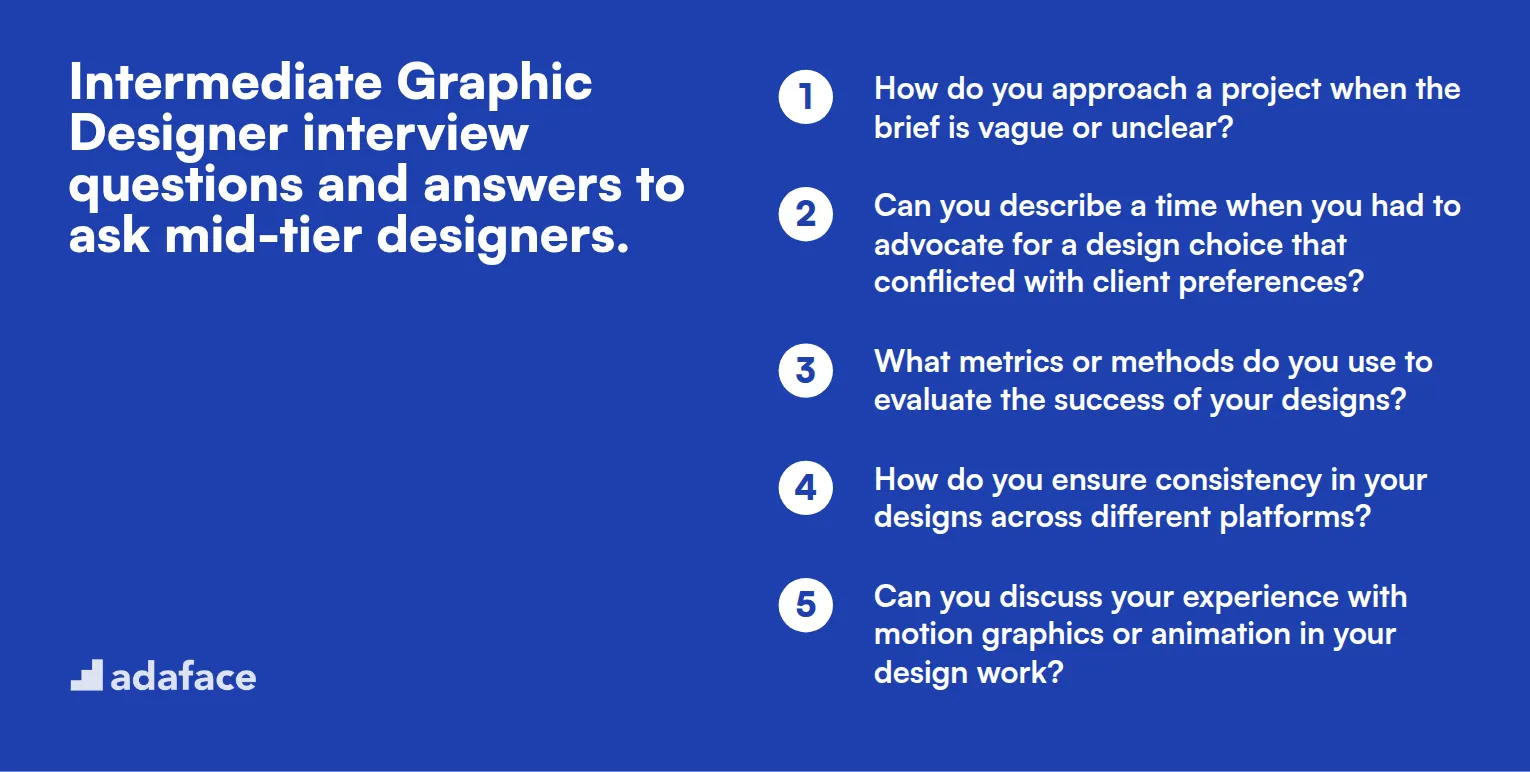
To gauge the skills and creativity of mid-tier graphic designers, use these targeted questions during interviews. They will help you assess not only their design capabilities but also their ability to adapt and think critically in various situations. For a comprehensive understanding of what to look for in a candidate, check out the graphic designer job description.
- How do you approach a project when the brief is vague or unclear?
- Can you describe a time when you had to advocate for a design choice that conflicted with client preferences?
- What metrics or methods do you use to evaluate the success of your designs?
- How do you ensure consistency in your designs across different platforms?
- Can you discuss your experience with motion graphics or animation in your design work?
- How do you approach revisions when working with clients who have multiple stakeholders?
- What role does feedback from non-designers play in your design process?
- How do you balance creativity with the practical constraints of a project?
- Can you share an example of how you've used data or research to inform your design decisions?
- What strategies do you use to manage client expectations throughout a project?
- How do you approach branding projects that require an understanding of a client's target market?
- Can you explain how you stay organized and maintain attention to detail in your design work?
5 advanced Graphic Designer interview questions and answers to evaluate senior designers
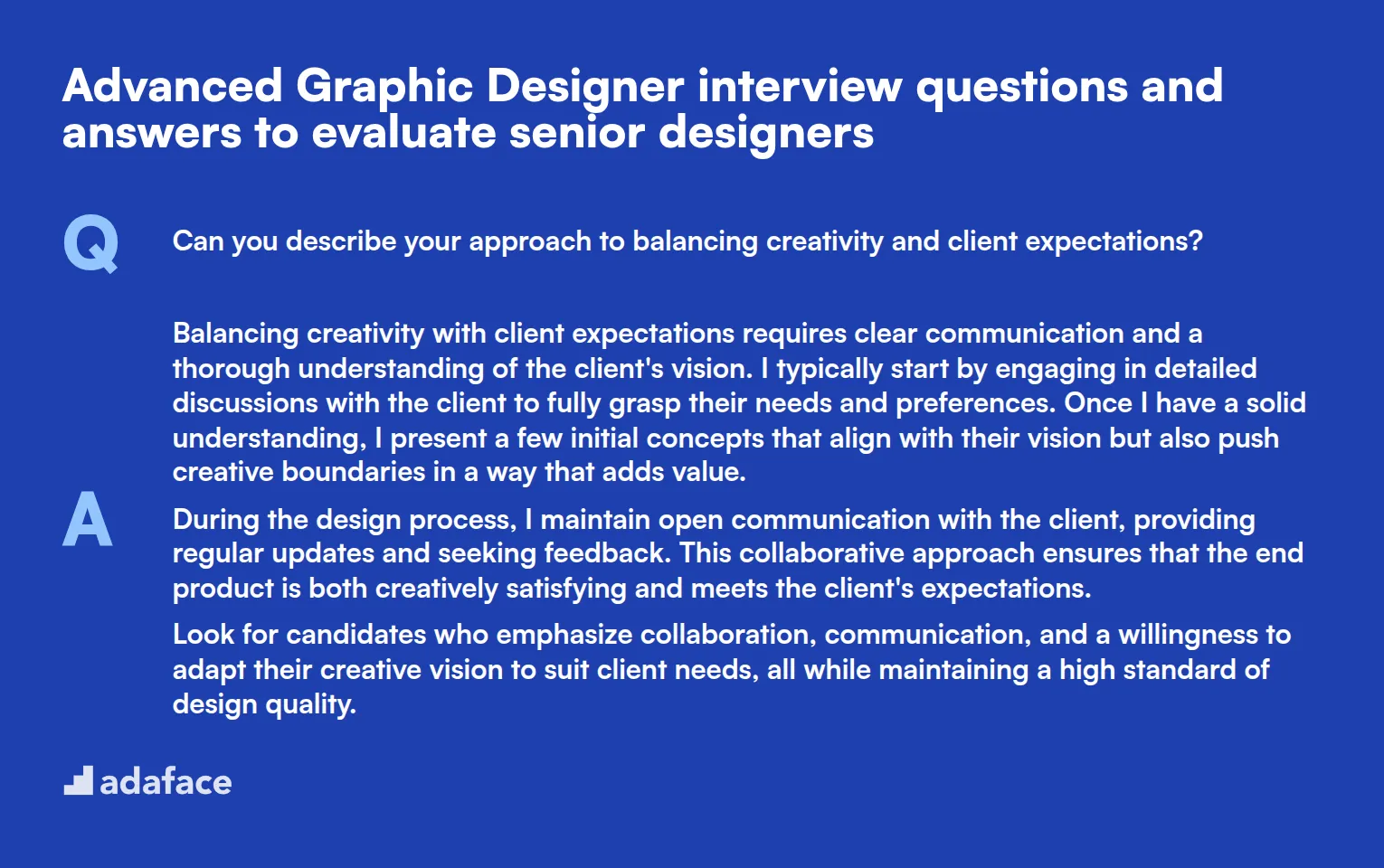
For those looking to hire a graphic design wizard, these advanced interview questions can help you delve deeper into the minds of senior designers. Not only do they provide insights into candidates' creative prowess, but they also reveal how they tackle complex design challenges. Use this list to ensure that your next hire is not just a designer, but a creative force ready to elevate your projects.
1. Can you describe your approach to balancing creativity and client expectations?
Balancing creativity with client expectations requires clear communication and a thorough understanding of the client's vision. I typically start by engaging in detailed discussions with the client to fully grasp their needs and preferences. Once I have a solid understanding, I present a few initial concepts that align with their vision but also push creative boundaries in a way that adds value.
During the design process, I maintain open communication with the client, providing regular updates and seeking feedback. This collaborative approach ensures that the end product is both creatively satisfying and meets the client's expectations.
Look for candidates who emphasize collaboration, communication, and a willingness to adapt their creative vision to suit client needs, all while maintaining a high standard of design quality.
2. How do you determine the most effective design strategy for a new project?
Determining the most effective design strategy involves a combination of research, brainstorming, and client collaboration. I begin by conducting thorough research to understand the market, the target audience, and any existing brand elements. This research informs the design direction and helps identify key visual elements that will resonate with the audience.
Next, I brainstorm various design concepts and evaluate their potential impact, considering factors such as usability, aesthetics, and brand alignment. I then present the most promising concepts to the client for feedback and make adjustments based on their input.
Ideal candidates should demonstrate a methodical approach to strategy development, including research, ideation, and client collaboration, ensuring the final design is both innovative and effective.
3. Discuss a time when you had to adapt your design style to suit a project’s unique needs.
Adapting my design style to suit a project’s needs often involves stepping outside of my comfort zone. In one instance, I worked on a project for a tech startup that required a minimalist aesthetic, which was quite different from my usual vibrant and detailed style. I took the time to study minimalist design principles, focusing on simplicity and functionality while ensuring the design still carried the brand's essence.
By experimenting with different approaches and continuously refining my work based on client feedback, I successfully delivered a design that met the project’s unique requirements while still reflecting my creative input.
Candidates should be able to share specific examples of how they’ve adapted their style, demonstrating flexibility and a willingness to learn new techniques or approaches to meet project demands.
4. How do you ensure your designs are user-centric and enhance user experience?
To ensure designs are user-centric, I incorporate user feedback and usability testing throughout the design process. This starts with understanding user personas and their needs, followed by creating prototypes to visualize how users will interact with the design.
I conduct usability tests with real users to gather insights on how the design functions in practice. This feedback is invaluable in making iterative improvements that enhance the overall user experience.
Strong candidates will describe a process that includes user research, testing, and iterative design refinements, emphasizing the importance of user feedback in creating successful designs.
5. What strategies do you employ to keep your design work innovative and fresh?
Staying innovative in design requires continuous learning and exposure to new ideas. I regularly follow design blogs, attend workshops, and participate in design communities to stay updated with the latest trends and techniques. This helps me bring fresh perspectives and techniques into my work.
I also experiment with new tools and design approaches in personal projects, which allows me to explore creative avenues without the constraints of client expectations. This exploration often leads to new insights and techniques that I can apply to professional projects.
Look for candidates who actively seek out new ideas and technologies, demonstrating a commitment to continuous improvement and innovation in their design work.
10 Graphic Designer questions related to design principles
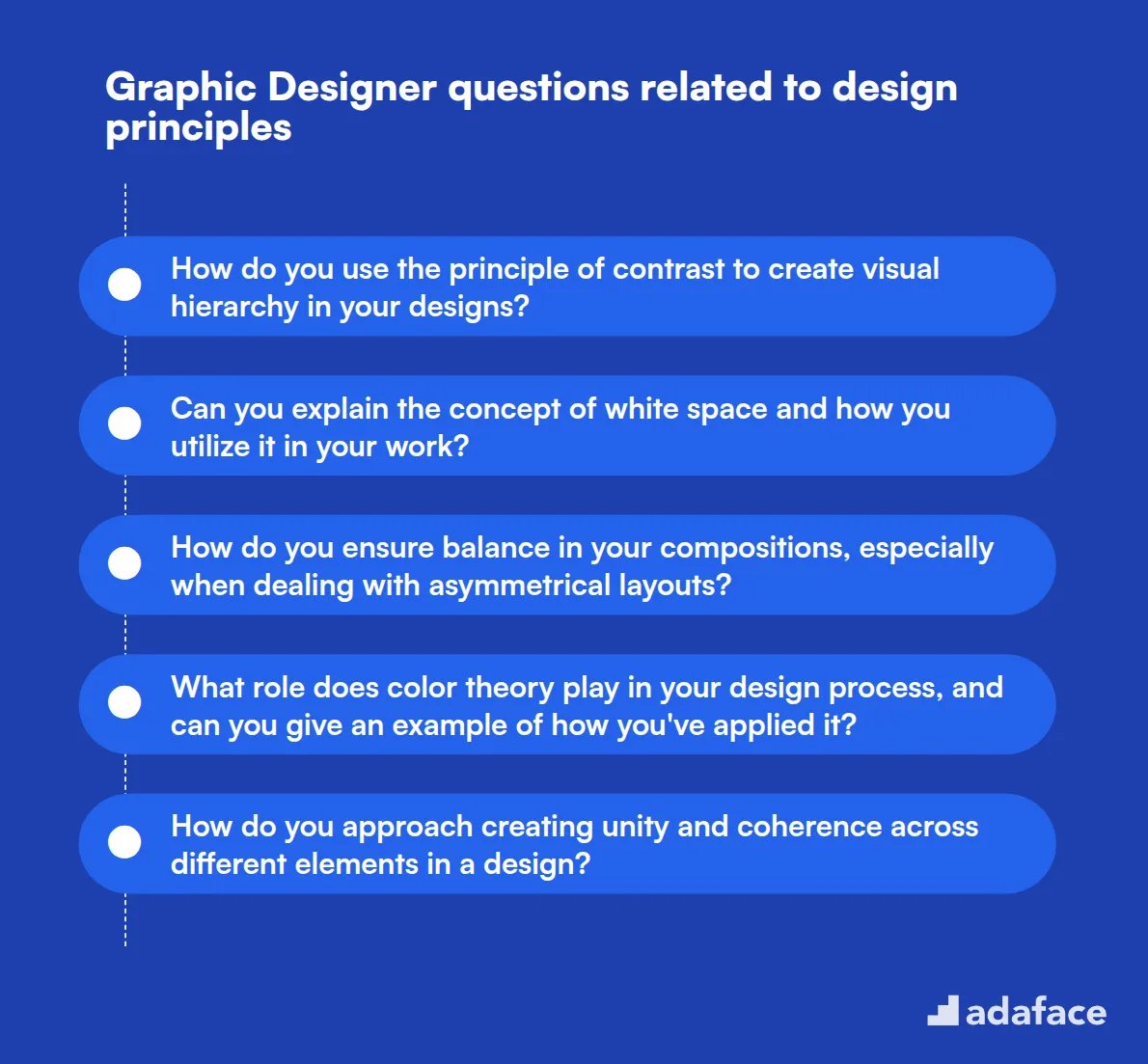
To assess a candidate's grasp of fundamental design principles, use these 10 graphic designer interview questions. These questions will help you evaluate the applicant's understanding of core concepts and their ability to apply them in real-world scenarios.
- How do you use the principle of contrast to create visual hierarchy in your designs?
- Can you explain the concept of white space and how you utilize it in your work?
- How do you ensure balance in your compositions, especially when dealing with asymmetrical layouts?
- What role does color theory play in your design process, and can you give an example of how you've applied it?
- How do you approach creating unity and coherence across different elements in a design?
- Can you explain the concept of rhythm in design and how you incorporate it into your work?
- How do you use scale and proportion to create emphasis or draw attention to specific elements?
- What strategies do you employ to ensure your designs are both aesthetically pleasing and functional?
- How do you apply the principle of repetition to create consistency in your designs?
- Can you discuss how you use the golden ratio or rule of thirds in your compositions?
8 Graphic Designer questions related to typography

To identify candidates with a strong understanding of typography, consider asking these targeted questions during your interview process. Typography is a crucial aspect of any design role, and the right questions can help uncover a designer's ability to effectively use type to enhance visual communication. For further insights into the skills required for a graphic designer, explore our comprehensive guide.
- Can you discuss a project where typography played a key role in its success?
- How do you choose typefaces to convey specific moods or messages in your designs?
- What factors do you consider when pairing fonts for a project?
- How do you ensure readability and legibility in your typographic choices across different devices?
- Can you explain how typography can influence the hierarchy of information in a design?
- What are some common typography mistakes that designers should avoid?
- How do you approach creating typographic systems that are consistent yet flexible?
- Can you describe a time when you had to educate a client or team member about the importance of typography in a project?
10 behavioral Graphic Designer interview questions
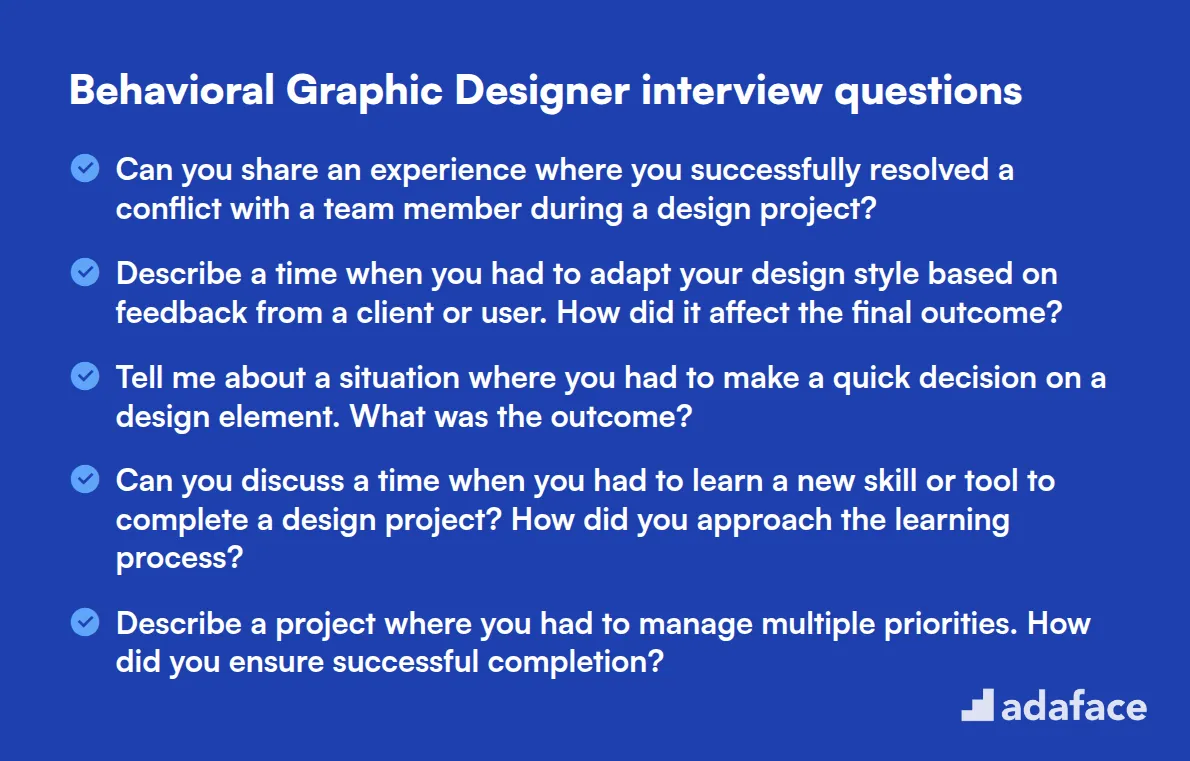
To effectively evaluate a candidate's soft skills and cultural fit within your team, consider incorporating these behavioral graphic designer interview questions into your hiring process. These questions will help you understand how candidates think, react, and collaborate in various scenarios, ensuring you find the right match for your graphic designer role.
- Can you share an experience where you successfully resolved a conflict with a team member during a design project?
- Describe a time when you had to adapt your design style based on feedback from a client or user. How did it affect the final outcome?
- Tell me about a situation where you had to make a quick decision on a design element. What was the outcome?
- Can you discuss a time when you had to learn a new skill or tool to complete a design project? How did you approach the learning process?
- Describe a project where you had to manage multiple priorities. How did you ensure successful completion?
- Can you share an example of a time when your design work positively impacted a team or organization beyond the project?
- Tell me about a time when you took the lead on a design project. What challenges did you face, and how did you overcome them?
- Can you describe a situation where you had to persuade stakeholders to support your design vision? What strategies did you use?
- Have you ever worked on a project that required you to step outside your comfort zone? How did it change your perspective?
- What do you do when a project doesn't go as planned? Can you share an instance and how you handled it?
Which Graphic Designer skills should you evaluate during the interview phase?
While a single interview might not reveal everything about a candidate's capabilities, it's crucial to focus on key skills that indicate potential success in a graphic design role. These core skills are fundamental in assessing whether a candidate can meet the demands of the position and align with your company's creative goals.
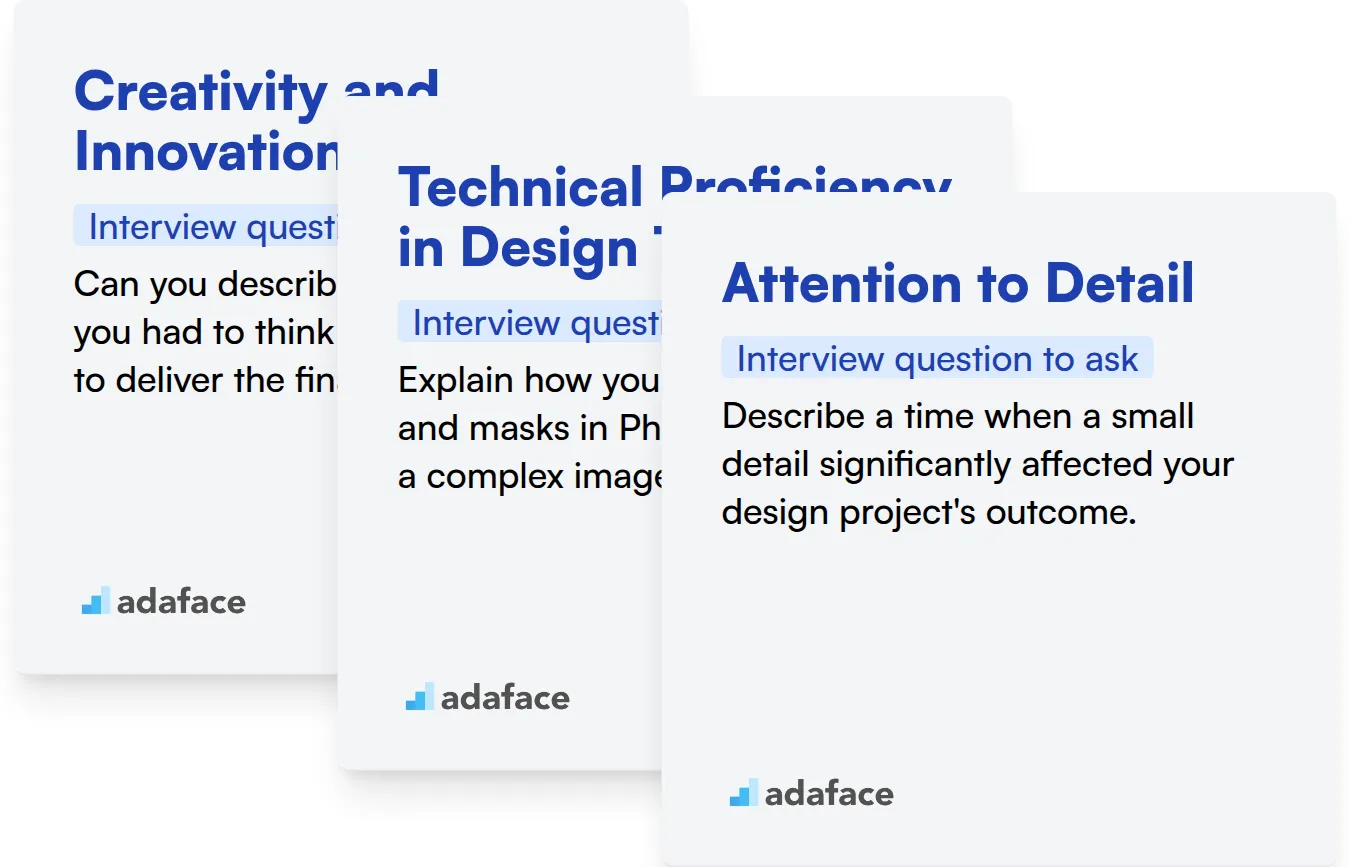
Creativity and Innovation
Creativity stands at the heart of graphic design. It's what transforms standard ideas into engaging visual stories. A graphic designer's ability to think outside the box and bring fresh perspectives is key to staying competitive in the industry.
To assess creativity quantitatively, consider including MCQs that explore problem-solving and creative thinking. While Adaface does not have a specific test for creativity, a custom assessment could be configured to gauge these skills effectively.
During the interview, asking about their creative process can provide deep insights into a candidate's innovative thinking.
Can you describe a project where you had to think outside the box to deliver the final design?
Look for detailed descriptions of their thought process, the challenges faced, and how they overcame them. Effective answers should demonstrate not only creativity but the ability to execute ideas successfully.
Technical Proficiency in Design Tools
Mastery of design software like Adobe Photoshop, Illustrator, and InDesign is fundamental for any graphic designer. This technical skill ensures that they can efficiently translate their creative ideas into digital formats.
To objectively assess their software skills, consider using Adaface's Adobe Indesign assessment test. This test evaluates candidates' proficiency with key design tools.
To further evaluate their practical software skills, ask a specific question related to everyday tool usage.
Explain how you would use layers and masks in Photoshop to create a complex image composition.
Assess the candidate's familiarity with essential functions and their ability to leverage these tools creatively. Effective answers will demonstrate both knowledge and the ability to apply that knowledge practically.
Attention to Detail
In graphic design, the smallest details can make a significant impact. Precision and a keen eye for detail are necessary to produce high-quality, polished work that accurately reflects the creative brief.
You can gauge this skill effectively with Adaface's attention-to-detail-test, which assesses candidates on their ability to meticulously manage tasks.
To explore how candidates handle detailed work, include a targeted question in your interview.
Describe a time when a small detail significantly affected your design project's outcome.
Look for answers that show an understanding of how minor elements affect the overall design and the steps they take to manage these details.
Tips for Conducting Effective Graphic Designer Interviews
Before putting your new knowledge to use, consider these tips to make your Graphic Designer interviews more productive and insightful.
1. Start with a Skills Assessment
Begin your hiring process with a skills assessment to quickly identify top candidates. This approach saves time and ensures you're interviewing the most qualified applicants.
For Graphic Designers, consider using a Graphic Designer Assessment that evaluates visual design skills, software proficiency, and problem-solving abilities. You might also include a Visual Reasoning Test to assess spatial awareness and pattern recognition.
By implementing these tests, you'll create a shortlist of candidates who have demonstrated the necessary technical skills. This allows you to focus your interviews on assessing cultural fit, communication abilities, and specific project experiences.
2. Prepare a Balanced Set of Interview Questions
With limited interview time, it's crucial to ask the right mix of questions. Aim for a balance between technical skills, creativity, and soft skills to get a well-rounded view of each candidate.
Consider including questions about UI/UX design principles, as many Graphic Designers work on digital projects. You might also want to explore their knowledge of current design trends and tools.
Don't forget to assess soft skills like teamwork and time management. These are essential for success in most design roles and complement the technical abilities you've already evaluated through skills tests.
3. Ask Thoughtful Follow-up Questions
Prepared questions are a great starting point, but follow-up questions often reveal a candidate's true depth of knowledge and experience. They help you distinguish between memorized answers and genuine understanding.
For example, if a candidate mentions using a specific design technique, ask them to explain why they chose that approach and what alternatives they considered. This probes their decision-making process and design rationale, giving you valuable insights into their problem-solving skills and creativity.
Streamline your Graphic Designer hiring process with skill tests and interviews
Want to hire top-notch Graphic Designers? Make sure you're assessing their skills accurately. The most effective way to do this is by using skill tests. Our Graphic Designer Assessment and Visual Reasoning Test can help you evaluate candidates' abilities objectively.
After using these tests to shortlist the best applicants, you can invite them for interviews. Ready to improve your hiring process? Sign up for Adaface or explore our Online Assessment Platform to get started with skill-based hiring.
Graphic Designer Aptitude Test
Download Graphic Designer interview questions template in multiple formats
Graphic Designer Interview Questions FAQs
Key skills include creativity, proficiency in design software, attention to detail, and a solid understanding of design principles.
Ask them to discuss their portfolio, describe their design process, and present a solution to a design challenge.
Common software includes Adobe Creative Suite (Photoshop, Illustrator, InDesign) and other tools like Sketch or Figma.
A portfolio is crucial as it showcases the designer's style, skills, and ability to tackle various projects.
Ask about past projects, challenges faced, how they handle feedback, and their approach to deadlines.
Inquire about their experience with typography in design projects and ask them to critique a piece of typography.

40 min skill tests.
No trick questions.
Accurate shortlisting.
We make it easy for you to find the best candidates in your pipeline with a 40 min skills test.
Try for freeRelated posts
Free resources




